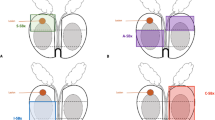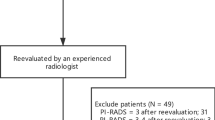Abstract
Background:
The predictive value of the abnormality side during digital rectal examination (DRE) has never been studied, suggesting that physicians examined the left lobe of the gland as well as the right lobe. We aimed to assess the predictive value of the side of DRE abnormality for prostate cancer (PCa) detection and aggressiveness in right-handed urologists.
Methods:
An analysis of a prospective database was carried out that included all consecutive men undergoing prostate biopsies between 2001 and 2012. The main end point was the predictive value of the abnormality side during DRE for cancer detection in clinically suspicious unilateral T2 disease. The diagnostic performance of left- versus right-sided abnormality was also assessed in terms of sensitivity, specificity and negative/positive predictive values.
Results:
Overall, 308 patients had a suspicious unilateral clinical disease (detection rate 57.5%). The cancer detection rate was significantly higher in case of left-sided compared with right-sided clinical T2 stage (odds ratio 2.1). In case of left-sided disease, the number of positive cores, the rate of perineural invasion, the rate of primary grade 4 pattern and the percentage of cancer involvement per core were significantly higher compared with those reported for right-sided disease. The predictive value of abnormality laterality for cancer detection and aggressiveness remained statistically independent in multivariate models. The positive predictive value for cancer detection was 64.6 in case of suspicious left-sided disease versus 46.9 in case of right-sided disease.
Conclusions:
The risks of detecting PCa and aggressive disease on biopsy are significantly higher when DRE reveals a suspicious left-sided clinical disease as compared with right-sided disease. Right-handed physicians should be aware of this variance in diagnostic performance and potential underdetection of left-sided clinical disease, and should improve their examination of the left lobe of the gland by conducting longer exams or changing the patient’s position.
This is a preview of subscription content, access via your institution
Access options
Subscribe to this journal
Receive 4 print issues and online access
$259.00 per year
only $64.75 per issue
Buy this article
- Purchase on Springer Link
- Instant access to full article PDF
Prices may be subject to local taxes which are calculated during checkout
Similar content being viewed by others
References
Center MM, Jemal A, Lortet-Tieulent J, Ward E, Ferlay J, Brawley O et al. International variation in prostate cancer incidence and mortality rates. Eur Urol 2012; 61: 1079–1092.
Siegel R, Naishadham D, Jemal A . Cancer statistics, 2013. CA Cancer J Clin 2013; 63: 11–30.
Draisma G, Boer R, Otto SJ, van der Cruijsen IW, Damhuis RA, Schröder FH et al. Lead times and overdetection due to prostate-specific antigen screening: estimates from the European Randomized Study of Screening for Prostate Cancer. J Natl Cancer Inst 2003; 95: 868–878.
Moore AL, Dimitropoulou P, Lane A, Powell PH, Greenberg DC, Brown CH et al. Population-based prostate-specific antigen testing in the UK leads to a stage migration of prostate cancer. BJU Int 2009; 104: 1592–1598.
Galper SL, Chen MH, Catalona WJ, Roehl KA, Richie JP, D'Amico AV . Evidence to support a continued stage migration and decrease in prostate cancer specific mortality. J Urol 2006; 175: 907–912.
Jhaveri FM, Klein EA, Kupelian PA, Zippe C, Levin HS . Declining rates of extracapsular extension after radical prostatectomy: evidence for continued stage migration. J Clin Oncol 1999; 17: 3167–3172.
Epstein JI, Walsh PC, Carmichael M, Brendler CB . Pathologic and clinical findings to predict tumor extent of nonpalpable (stage T1c) prostate cancer. JAMA 1994; 271: 368–374.
Schröder FH, Hugosson J, Roobol MJ, Tammela TL, Ciatto S, Nelen V et al. ERSPC Investigators. Prostate-cancer mortality at 11 years of follow-up. N Engl J Med 2012; 366: 981–990.
Andriole GL, Crawford ED, Grubb 3rd RL, Buys SS, Chia D, Church TR et al. Mortality results from a randomized prostate-cancer screening trial. N Engl J Med 2009; 360: 1310–1319 PLCO Project Team.
van Vugt HA, Roobol MJ, Kranse R, Määttänen L, Finne P, Hugosson J et al. Prediction of prostate cancer in unscreened men: external validation of a risk calculator. Eur J Cancer 2011; 47: 903–909.
Ankerst DP, Boeck A, Freedland SJ, Thompson IM, Cronin AM, Roobol MJ et al. Evaluating the PCPT risk calculator in ten international biopsy cohorts: results from the Prostate Biopsy Collaborative Group. World J Urol 2012; 30: 181–187.
Garzotto M, Hudson RG, Peters L, Hsieh YC, Barrera E, Mori M et al. Predictive modeling for the presence of prostate carcinoma using clinical, laboratory, and ultrasound parameters in patients with prostate specific antigen levels<or=10 ng/mL. Cancer 2003; 98: 1417–1422.
Gosselaar C, Roobol MJ, Roemeling S, Schröder FH . The role of the digital rectal examination in subsequent screening visits in the European randomized study of screening for prostate cancer (ERSPC), Rotterdam. Eur Urol 2008; 54: 581–588.
Thompson IM, Pauler DK, Goodman PJ, Tangen CM, Lucia MS, Parnes HL et al. Prevalence of prostate cancer among men with a prostate-specific antigen level<or =4.0 ng per milliliter. N Engl J Med 2004; 350: 2239–2246.
Baumgart LA, Gerling GJ, Bass EJ . Characterizing the range of simulated prostate abnormalities palpable by digital rectal examination. Cancer Epidemiol 2010; 34: 79–84.
Gosselaar C, Kranse R, Roobol MJ, Roemeling S, Schröder FH . The interobserver variability of digital rectal examination in a large randomized trial for the screening of prostate cancer. Prostate 2008; 68: 985–993.
de la Taille A, Antiphon P, Salomon L, Cherfan M, Porcher R, Hoznek A et al. Prospective evaluation of a 21-sample needle biopsy procedure designed to improve the prostate cancer detection rate. Urology 2003; 61: 1181–1186.
Güth U, Huang DJ, Huber M, Schötzau A, Wruk D, Holzgreve W et al. Tumor size and detection in breast cancer: self examination and clinical breast examination are at their limit. Cancer Detect Prev 2008; 32: 224–228.
Fletcher SW, O'Malley MS, Bunce LA . Physicians’ abilities to detect lumps in silicone breast models. JAMA 1985; 253: 2224–2228.
Thompson IM, Ankerst DP, Chi C, Goodman PJ, Tangen CM, Lucia MS et al. Assessing prostate cancer risk: results from the Prostate Cancer Prevention Trial. J Natl Cancer Inst 2006; 98: 529–534.
Borden Jr LS, Wright JL, Kim J, Latchamsetty K, Porter CR . An abnormal digital rectal examination is an independent predictor of Gleason>or =7 prostate cancer in men undergoing initial prostate biopsy: a prospective study of 790 men. BJU Int 2007; 99: 559–563.
Gosselaar C, Roobol MJ, van den Bergh RC, Wolters T, Schröder FH . Digital rectal examination and the diagnosis of prostate cancer—a study based on 8 years and three screenings within the European Randomized Study of Screening for Prostate Cancer (ERSPC), Rotterdam. Eur Urol 2009; 55: 139–146.
Romero FR, Romero AW, Tambara Filho R, Brenny Filho T, de Oliveira Júnior FC . Patient positioning during digital rectal examination of the prostate: preferences, tolerability, and results. Int Braz J Urol 2011; 37: 371–377.
Romero FR, Romero KR, Brenny FT, Pilati R, Kulysz D, de Oliveira Júnior FC . Reasons why patients reject digital rectal examination when screening for prostate cancer. Arch Esp Urol 2008; 61: 759–765.
Frank J, Thomas K, Oliver S, Andrews S, Choong S, Taylor R et al. Couch or crouch? Examining the prostate: a randomized study comparing the knee-elbow and the left-lateral position. BJU Int 2001; 87: 331–333.
Furlan AB, Kato R, Vicentini F, Cury J, Antunes AA, Srougi M . Patient’s reactions to digital rectal examination of the prostate. Int Braz J Urol 2008; 34: 572–575.
Chu DI, De Nunzio C, Gerber L, Thomas 2nd JA, Calloway EE, Albisinni S et al. Predictive value of digital rectal examination for prostate cancer detection is modified by obesity. Prostate Cancer Prostatic Dis 2011; 14: 346–353.
Moore CM, Robertson NL, Arsanious N, Middleton T, Villers A, Klotz L et al. Image-guided prostate biopsy using magnetic resonance imaging-derived targets: a systematic review. Eur Urol 2013; 63: 125–140.
Author information
Authors and Affiliations
Corresponding author
Ethics declarations
Competing interests
The authors declare no conflict of interest.
Rights and permissions
About this article
Cite this article
Ploussard, G., Nicolaiew, N., Mongiat-Artus, P. et al. Left lobe of the prostate during clinical prostate cancer screening: the dark side of the gland for right-handed examiners. Prostate Cancer Prostatic Dis 17, 157–162 (2014). https://doi.org/10.1038/pcan.2014.2
Received:
Revised:
Accepted:
Published:
Issue Date:
DOI: https://doi.org/10.1038/pcan.2014.2



